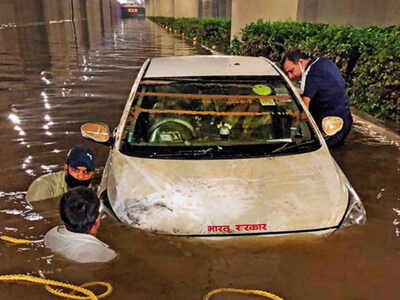
GURUGRAM: Even as most arterial roads in the city witnessed waterlogging on Wednesday, the condition of Golf Course Road took government bodies completely by surprise as the stretch had not appeared anywhere in the critical points list that they had prepared.
The developer, DLF, blamed the city’s ‘insufficient drainage infrastructure’. Till Thursday morning, nearly 50 to 60 MLD water was pumped out of one of the seven underpasses on the road, in DLF Phase 1. Till the time this report was filed, one of them had not been cleared. Teams from the GMDA and DLF also visited the stretch to identify the cause of the problem.
A GMDA official, requesting anonymity, said that water from the expressway is routed to the Wazirabad dam through Hamilton Court Road. “There seems to be a fault in that connecting link. There was also something amiss with the drainage system of the expressway as water from most parts of the city was pumped out within four hours but it took much longer on Golf Course Road,” he said.
Golf Course Road, built for nearly Rs 600 crore in one of the most upscale parts of the city, was unable to handle Wednesday’s downpour, recorded at 95mm. The underpasses on the road, where many MNCs, malls, schools, residential complexes and government offices are located, saw 12-15 feet of waterlogging.
GMDA chief VS Kundu told TOI that they had never anticipated the waterlogging on Golf Course Road. “We had prepared a list of 33 critical points for waterlogging in the city and the Golf Course Road never figured on the list. There must be a problem at the outlet. I will talk to DLF and find out what caused the flooding on the expressway,” he said.
Golf Course Road was developed as a model road by DLF and Haryana Shahari Vikas Pradhikaran (HSVP) on a 50-50% partnership, but the developer executed the work. Some HSVP officials said while the developer had made several promises in the initial proposals, it had failed to fulfil many of them.
“It had promised a state-of-the-art drainage system and a design to ensure that there is no waterlogging during monsoon season. All the underpasses are equipped with an efficient drainage system designed to discharge stormwater,” said a HSVP official, requesting anonymity.
This was to be done with the installation of a hydrodynamic separator for each underpass and U-turn. Each underpass has a separate sump well to collect water, which depends on the size and length of the underpass. The underpasses have discharge pumps that are installed in two stages to ensure there is no flooding of the sump wells. The first stage pump becomes operational when the water level starts increasing and if it breaches the dead storage mark of the first pump, the second stage pump automatically starts its operations.
The official added that the proposal also mentioned that there would be additional standby pumps in case of any emergency or excessive water flow. The developer had also said that the entire system would be automatic and sump wells are designed to percolate almost 30% rainwater in the ground. This was to raise the groundwater level, thereby strengthening the depleting water tables of Gurugram, the official added.
When asked, DLF dismissed the claims and said that their drainage system is as stated in the proposals.
“The underpasses on Raghavendra Marg have been in use for the past three to four years. So far, we had never experienced waterlogging of this magnitude. The intensity of rainfall received this time was six to seven times higher than the designed capacity of the master drainage system of Gurugram,”said a DLF spokesperson.
He added that of the seven underpasses on Raghavendra Marg, six are fully operational. “The seventh underpass on Arjun Marg in DLF Phase 1 was severely impacted due to reverse discharge of rainwater from the main drainage system. Teams from DLF and the government bodies are conducting the repairs and it will be operational by Friday morning,” he said.
In Video:Gurugram: Caught by surprise, agencies looking for causes of Golf Course Road flood
The developer, DLF, blamed the city’s ‘insufficient drainage infrastructure’. Till Thursday morning, nearly 50 to 60 MLD water was pumped out of one of the seven underpasses on the road, in DLF Phase 1. Till the time this report was filed, one of them had not been cleared. Teams from the GMDA and DLF also visited the stretch to identify the cause of the problem.
A GMDA official, requesting anonymity, said that water from the expressway is routed to the Wazirabad dam through Hamilton Court Road. “There seems to be a fault in that connecting link. There was also something amiss with the drainage system of the expressway as water from most parts of the city was pumped out within four hours but it took much longer on Golf Course Road,” he said.
Golf Course Road, built for nearly Rs 600 crore in one of the most upscale parts of the city, was unable to handle Wednesday’s downpour, recorded at 95mm. The underpasses on the road, where many MNCs, malls, schools, residential complexes and government offices are located, saw 12-15 feet of waterlogging.
GMDA chief VS Kundu told TOI that they had never anticipated the waterlogging on Golf Course Road. “We had prepared a list of 33 critical points for waterlogging in the city and the Golf Course Road never figured on the list. There must be a problem at the outlet. I will talk to DLF and find out what caused the flooding on the expressway,” he said.
Golf Course Road was developed as a model road by DLF and Haryana Shahari Vikas Pradhikaran (HSVP) on a 50-50% partnership, but the developer executed the work. Some HSVP officials said while the developer had made several promises in the initial proposals, it had failed to fulfil many of them.
“It had promised a state-of-the-art drainage system and a design to ensure that there is no waterlogging during monsoon season. All the underpasses are equipped with an efficient drainage system designed to discharge stormwater,” said a HSVP official, requesting anonymity.
This was to be done with the installation of a hydrodynamic separator for each underpass and U-turn. Each underpass has a separate sump well to collect water, which depends on the size and length of the underpass. The underpasses have discharge pumps that are installed in two stages to ensure there is no flooding of the sump wells. The first stage pump becomes operational when the water level starts increasing and if it breaches the dead storage mark of the first pump, the second stage pump automatically starts its operations.
The official added that the proposal also mentioned that there would be additional standby pumps in case of any emergency or excessive water flow. The developer had also said that the entire system would be automatic and sump wells are designed to percolate almost 30% rainwater in the ground. This was to raise the groundwater level, thereby strengthening the depleting water tables of Gurugram, the official added.
When asked, DLF dismissed the claims and said that their drainage system is as stated in the proposals.
“The underpasses on Raghavendra Marg have been in use for the past three to four years. So far, we had never experienced waterlogging of this magnitude. The intensity of rainfall received this time was six to seven times higher than the designed capacity of the master drainage system of Gurugram,”said a DLF spokesperson.
He added that of the seven underpasses on Raghavendra Marg, six are fully operational. “The seventh underpass on Arjun Marg in DLF Phase 1 was severely impacted due to reverse discharge of rainwater from the main drainage system. Teams from DLF and the government bodies are conducting the repairs and it will be operational by Friday morning,” he said.
In Video:Gurugram: Caught by surprise, agencies looking for causes of Golf Course Road flood

Coronavirus outbreak
Trending Topics
LATEST VIDEOS
City
 On cam: Car washed away in flash flood in J&K's Kathua
On cam: Car washed away in flash flood in J&K's Kathua  Sushant Singh Rajput death: CBI to check CCTV of SSR's building for ‘tampering’
Sushant Singh Rajput death: CBI to check CCTV of SSR's building for ‘tampering’  India has changed and Pakistan needs to look into their own internal matters: VHP spokesperson Vinod Bansal
India has changed and Pakistan needs to look into their own internal matters: VHP spokesperson Vinod Bansal  Bengaluru riots: Karnataka govt plans ban on SDPI, PFI, seeks detailed police report
Bengaluru riots: Karnataka govt plans ban on SDPI, PFI, seeks detailed police report
More from TOI
Navbharat Times
Featured Today in Travel
Quick Links
Kerala Coronavirus Helpline NumberHaryana Coronavirus Helpline NumberUP Coronavirus Helpline NumberBareilly NewsBhopal NewsCoronavirus in DelhiCoronavirus in HyderabadCoronavirus in IndiaCoronavirus symptomsCoronavirusRajasthan Coronavirus Helpline NumberAditya ThackerayShiv SenaFire in MumbaiAP Coronavirus Helpline NumberArvind KejriwalJammu Kashmir Coronavirus Helpline NumberSrinagar encounter
Get the app



